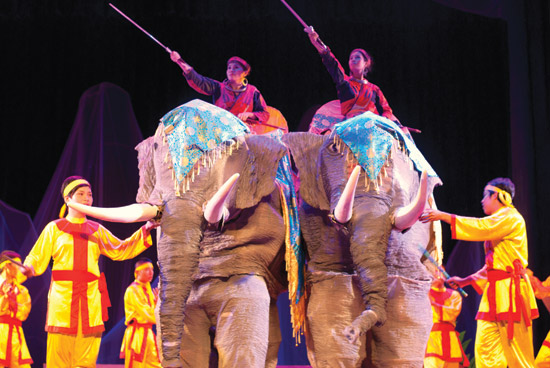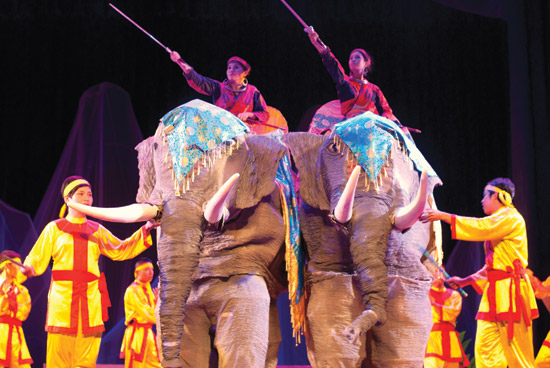(No.3, Vol.2 Mar 2012 Vietnam Heritage Magazine)
Twice a month at the Ho Chi Minh City Opera House a theatrical troupe from Mekong Artists serves up an extravaganza of a whole colourful kaleidoscope of traditional song, dance, music, street life and legends from Vietnamese culture. If I were to sum it all up in just three words and three punctuation marks, which I know you are not supposed to do in an introduction, I would describe it as ‘absolutely superlative degree!!!’ If there were Oscars for this kind of show the aptly named ‘Soul of Vietnam’ (H?n Vi?t) would sweep the board; best score, best choreography, best stage effects, best costumes, best performers, best script and best lighting.
Try to get there early, as you will be treated in the foyer to green tea as well as, ‘chè’ (usually translated as sweet soup) and cold spring rolls to be dipped in a peanut sauce. These are all served by ‘street vendors’ in traditional garbs complete with bamboo pole and baskets.
After this reminder that Vietnamese culture is all around for those who have eyes to see, I was ushered to the front row and seated next to a gentleman as illustrious as his name suggests, a co-founder of the troupe, Mr Richard Asinari di San Marzano. Those less privileged than I with_a_complimentary_ticket_pay VND100,000,_VND150,000_or VND300,000, which, given the large number of performers and the elaborate costumes and scenery, is a snip of a price. The show lasts an hour and proceeds at fast pace with never a dull moment. It comes in six acts. A fine lady dressed in traditional ao dai with her hat sparkling like diamonds in the stage lighting introduces each part. I shall proceed to describe just what you can expect to see in each one.
The first act depicts the legend of heroines the two Trung sisters. The opening takes you back to the early era of Vietnamese history with scenes of tiger-hunting and the tilling of the land. A toddler is led by her grandmother through the fields. Then there is the triumphant entry on parade of the sisters on quite realistic looking elephants. There is a fiery sword dance with warriors demonstrating their skills in battle reinforcing the brave struggle of the sisters to uphold Vietnamese independence.
This is followed by a dramatisation of a second popular tale namely that of Cuoi the Buffalo Boy and the Banyan Tree. Ingeniously, it starts with a child skipping, leading to a depiction of the gamut of games Vietnamese children traditionally play. They gather around a bearded storyteller with a man playing the flute in accompaniment as they listen to the tale itself. The stage is filled with colourful mist and you are transported to the jungle where Cuoi witnesses a tigress’s curing her injured cub with the leaves of a banyan tree. He sees the tree has magical qualities and uses it to cure people. Unfortunately the tree can only live by being tended with clean water. There follows a really memorable scene, as, one day, being desperate, the boy urinates on the tree, which uproots and, with Cuoi clinging to it like an acrobat, is transported to the moon. Great scenic effects!
On to the third act, in which you are treated to an education in Vietnamese musical instruments, folk song and the operatic C?i L??ng. To introduce this the narrator sings a time-honoured lullaby. On display are the more familiar instruments that contribute to the melodious sonority of Vietnamese music – the lute, zither, and ‘dan nhi’ or two-chord fiddle. Further adding to the sounds of the soul of Vietnam was one that fascinated me. A woman holding two ceramic teacups in each hand used them to the same effect as the Andalousians with castanets. A female soloist in a royal purple ao dai sings a song from the ancient capital of Hue. Then on stage come boats and there ensues a performance of the River Song, composed, as Richard informed me, in 1917. Finally, a four-string quartet performs livelily and in a style somewhat reminiscent of Irish folk music.
Act four I had seen before, and, bizarrely, far from Vietnam, in Northern Portugal, where the performers are called ‘Pauliteiros’. A line of dancers skip in and out of pairs of bamboo poles which are moved as in puppetry by people on both sides of them. The rhythmic clapping of the poles adds to the excitement and you may even find yourself foot-tapping away too. The costumes are of course different. This is a highland dance and the dancers wear bright-red and black ethnic clothing, but this fast-moving dodging dance is exactly the same. One wonders if the Portuguese learned it on their trading adventures in Hoi An port.
For our fifth treat the curtain rose for the H?n Vi?t ensemble, who performed behind a magnificent golden dragon boat. Richard points out that there are on stage some well known Vietnamese players, one of whom he describes as a ‘national treasure’. H?n Vi?t plays a gamut of traditional regional musical themes from the North, Centre and South.
Next it is the turn of street culture to the fore. It is all there minus the famous motorbikes. A massage-provider clicking her sticks is the first crier to appear from straight out of the audience. A lady hails a cyclo. Then on comes an ice-cream salesman and soon the stage is full of the cries of all manner of street hawkers and street life.
Just when you thought it could not possibly get any better it does, as this is followed by the grand finale. A man dressed in shaman-like clothing and looking like an Incan plays the ‘music of the mountains’ on a stone xylophone. Soon he is accompanied by a virtuoso performance on the bamboo flute at times imitating shrill birdsong. The flautist, who wrote the composition himself, is the famous Mr Do Loc. Now, to say his rendition took my breath away would be sheer understatement. I was left floundering on the floor gasping for paramedic attention!
Amazingly, all this has been packed into one hour and all these people who have provided so much pleasure assemble for the curtain call. All these talented people on stage and who should steal the attention with her coy little wave to the audience but the nineteen-month-old baby girl. Her proud Dad is none other than the person sitting next to me, Richard.
Hats off to Mekong Artists, who have provided me with my first ever rave review. If there is anyone sitting in the British Council reading this you could earn yourself a lot of kudos if you could carry off the coup of engaging this act for a UK tour.
In sum, this is a celebration of everything that is beautiful about this wonderful land. Along with the water puppetry this is a must see/do for any visitor to Vietnam. Dull would he be of spirit indeed anyone who could fail to be moved by this pot pourri of music, song dance and legend which comes all-inclusive of the strong contribution that both the ordinary person in the street and the highland minorities bring to Vietnamese culture.
Note H?n Vi?t/Soul of Vietnam plays at the Ho Chi Minh City Opera House at 5 p.m. every 15th and 23rd of the month.n
The Trung Sisters advance in H?n Vi?t
Photo: Soul of Vietnam

The bamboo dance
Photo: Soul of Vietnam


